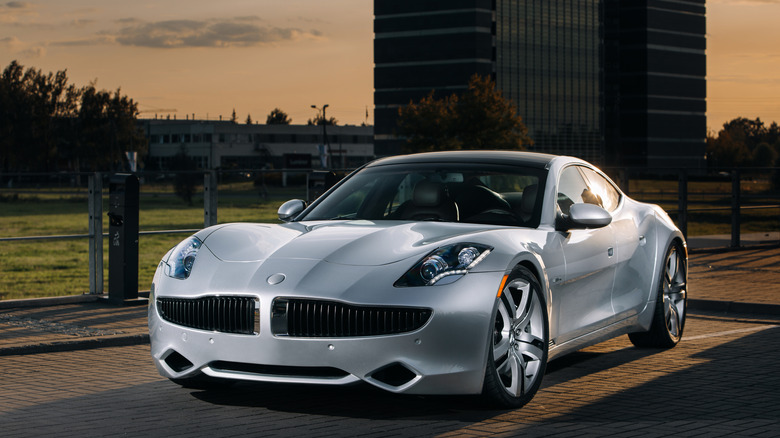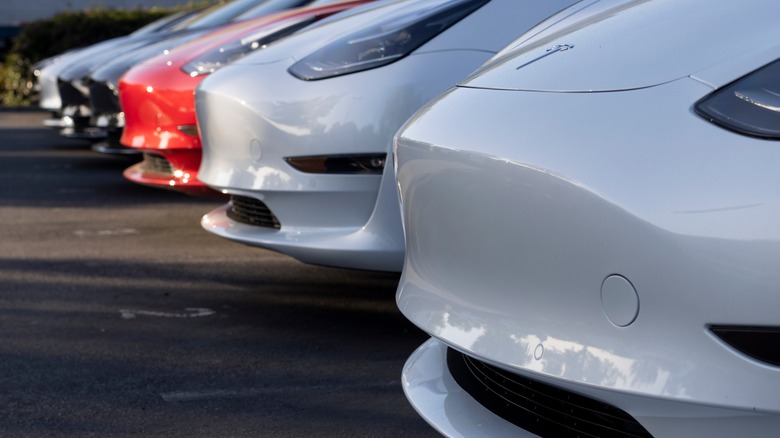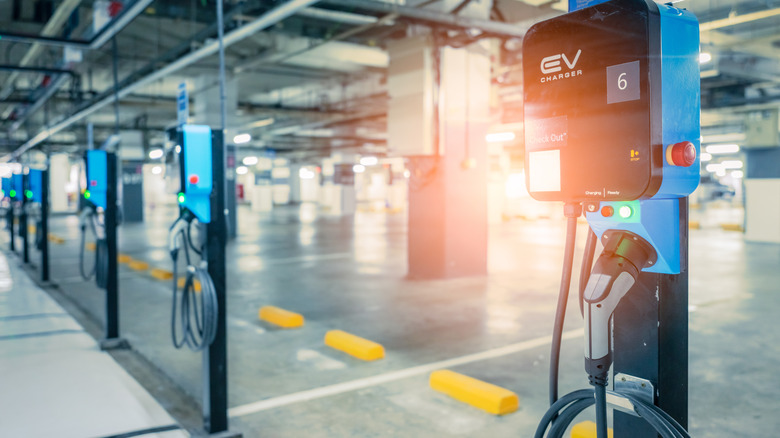Here's How Fisker Lost The EV Battle To Tesla
Everyone is likely familiar with the Tesla brand these days. Tesla has been a household name for years, and even as Forbes reports its market share is likely to diminish heading into 2023, the company still commands over 65% of the EV marketplace in the United States.
Modern incarnations of Tesla models are sleek and can slug it out with some of the best performers in range, across both the EV world and traditional internal combustion engine-powered vehicles. But early technology in this field looked a little different. The Economic Times reports that battery power was a typical sight for roadworthy vehicles in the 1800s and even into the early 20th century: In fact, The Times reports that about 33% of all automobiles in the U.S. were electric. Fast forward a century, and automotive manufacturing has seen a sort of 180. In 2003, Tesla Motors was founded by Martin Eberhard and Marc Tarpenning, and quickly gained the financial backing of one Elon Musk (via Investopedia). A few years later, in 2008, the company rolled out the first Tesla Roadster.
The rest, as they say, is history. But one little-known nugget in the rise to prominence that Tesla experienced was an early battle with rival EV brand Fisker. Named after Henrik Fisker of Aston Martin acclaim, Fisker also brought an EV to the market in 2008: The Fisker Karma.
What happened next is a story of intrigue, caution, and perhaps even resurgence.
Head to head: Production of the cars
The first problem that plagued Fisker was its production. The brand had built projections of selling 15,000 Fisker Karmas per year from 2009, the year after the vehicle was introduced, according to Reuters. Instead, production faltered, and it began delivering orders only in 2011, concluding production with less than 2,000 total units and losing a reported $35,000 or more on each sale. In contrast, Tesla sold just 2,400 Roadsters, but had allocated resources to build 2,500 total (rather than Fisker's ultimately unattainable targets).
Tesla, according to Business Insider developed the Roadster as a kind of niche product, rather than the widespread consumer good that Fisker clearly envisioned its Karma to be. In the end, Tesla was better positioned to take advantage of the market's appetite for this novel take on a classic mode of transportation. Production issues that saw parts poorly manufactured, missing, or broken, alongside a fundamental misreading of the consumer environment, left the Fisker brand vulnerable to instability. Unfortunately for Fisker, other shocks were waiting just around the corner and would push the brand out of play entirely.
Hurricane Sandy and bankruptcy
After a miscalculation of the marketplace, Fisker was placed in a vulnerable position because the company had borrowed heavily from the U.S. Federal Government — to the tune of $529 million through U.S. Department of Energy programs (via The Atlantic). This money was a part of $25 billion in assets earmarked to jumpstart the fledgling consumer marketplace for actionable research and development projects that would bring reliable EVs to U.S. roads.
The Atlantic notes that the DoE's analysis revealed future movement toward the adoption of EV technology wholesale (or, at least, as a majority share of future roadway mobility), and was seeking to inject energy and excitement into this sector at a time when oil prices and foreign imports were each showing signs of intense stress. Gas peaked at a blistering $5.10 per gallon — adjusted for inflation — in July 2008 (via U.S. Department of Energy). With war continuing in Iraq and Afghanistan, and renewed warfare expanding in Gaza (via Middle East Monitor), the energy sector certainly looked bleak. But with the introduction of flashy new EVs that could actually work as commuter vehicles, there was hope for an alternative.
In Fisker, this hope came crashing down when production delays and the loss of solar roof technology in a key partner's demise made the cars untenably expensive to produce. DoE regulators halted loans, and Fisker himself left the company. This pushed the brand into bankruptcy, and then Hurricane Sandy wiped out stocks of the product, crumbling any semblance of the bright future that Fisker once projected.
Is there a second coming on the horizon?
While Fisker ultimately declared bankruptcy and left the market in 2012, it was revived during a reserve merger with a SPACE called Spartan Energy in 2016 (via Entrepreneur). In addition to a renewal of the brand's name and mission, this second coming of Fisker is buoyed by the use of outsourced manufacturing and part production that may just trim off the waste that floundered the brand in its first format a decade ago.
Fisker stands as a potential challenger to Tesla, especially with the preeminent EV brand seeing its own recall issues for several Tesla models and manufacturing hiccups. Fisker may be positioned well to challenge Tesla for excellent market positioning when it comes to high end EVs that look beautiful and perform at an immensely high level.
But Fisker isn't the only name in this arena. Forbes reports that Tesla's initial "master plan" was to build flashy sports cars that sold for high figures in an effort to fund the production of affordable EVs that dominated the market for lower cost commuter vehicles and family cars. Yet, more than 10 years removed from this mission to develop a range of EVs to capture all financial rungs of the automotive sales pipeline, Forbes notes that General Motors has effectively built a stranglehold on the low-cost EV market.
With pressure on both ends of the spectrum (the cheap EV and the expensive one), Tesla may be forced to fight hard battles across all fronts of its industry. Fisker lost the EV battle to its rival in the early stages, but the war isn't over yet.



